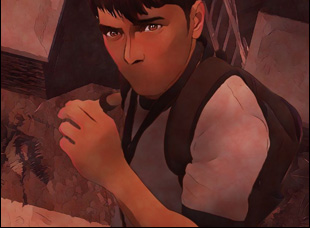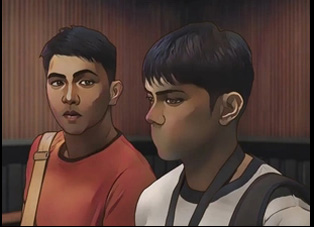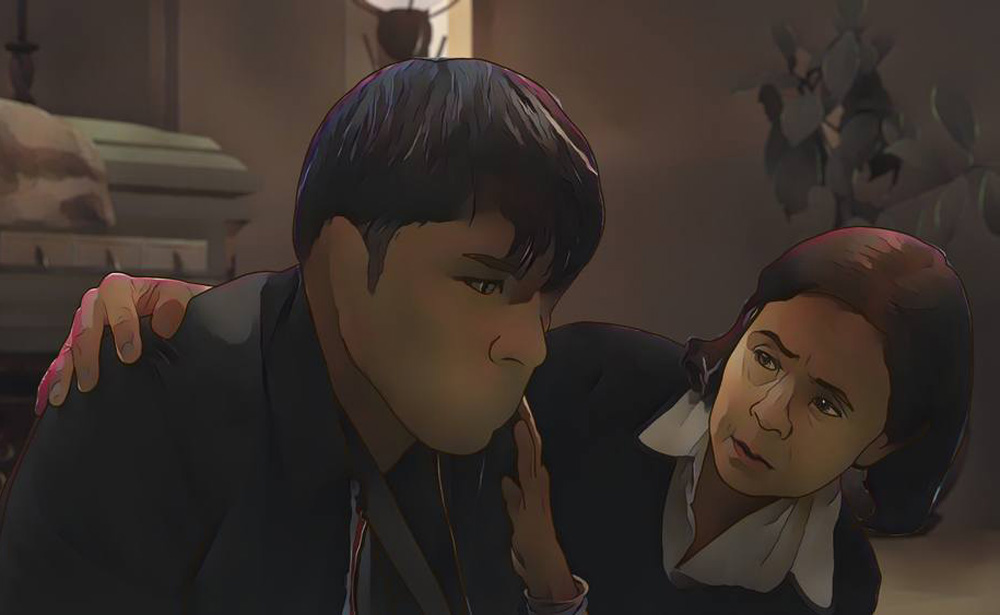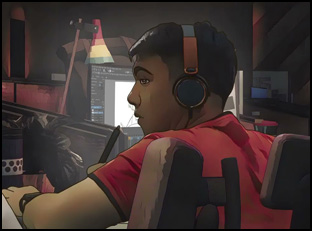It surely isn’t an accident that Carl Joseph Papa decided that Eric (Carlo Aquino) would be an animator like himself in “The Missing,” spending his days leaving the world behind as he stares at his computer giving life to others in an alternate reality. For Papa, the film was always meant to be only lightly autobiographical when showing how his profession could become a refuge from a particularly painful moment, but also naturally taking full advantage of it as a form of expression when other modes of communication would surely fail him, reflecting the fact that Eric has been a mute for years by blurring the area on his face where his lips ordinarily would be. Still, the character draws as a way to take his mind off the recent disappearance and possible death of his uncle Rogelio, a shadowy figure from his past that he wouldn’t give any thought to at all if it weren’t for the admonitions of his mother Rosalinda (Dolly de Leon) to help locate him when his whereabouts are unknown.
She’s asking far more than she could know in sci-fi tinged drama where Eric isn’t only required to peek into dark corners of his neighborhood to try and locate Rogelio’s body, but sift through the recesses of his own mind through long-suppressed memories. He has some distractions, both in the company he keeps as his co-worker Carlo (Gio Gahol) joins him in his search and the recurring dream he has of being abducted by aliens that he previously had as a kid, curiously resurfacing only now that he’s reminded of his uncle again, and as he wanders through different dimensions of both his own consciousness and the unfamiliar places his search for Rogelio is naturally taking him, Papa’s shrewd use of “Waking Life”-style rotoscope allows a semblance of Eric to always been seen while his spirit is moved in different ways. While the character’s disorientation sets in, the pain he’s processing is acutely felt, gradually collecting the strength to have control over his own destiny after feeling inhibited for so long and “The Missing” starts takes shape as Eric starts to feel more complete and confident in who he is.
Made in a whirlwind as part of a local competition in the Philippines, “The Missing” is now starting to take the world by storm after the country named Papa’s third feature its official selection for this year’s International Feature category at the Oscars and recently while in Los Angeles, the filmmaker spoke about how a story that was close to him personally evolved into something far bigger than himself, finding the right formal style to express what the characters were feeling and the process of bringing the energy from performances on set into the realm of animation.
It all came to me around 2018, based on personal experience and what happened to me when I was young was not as bad as what happens in the film, but I used it as inspiration, along with the interviews with other people who underwent the same thing [in terms of] trauma and childhood. [That process] made me have more perspective over the subject matter and it made the story more accessible, and it broadened my perspective with the subject matter because it became something more than just my story.
At first, [there] was an angrier version of it, and then it evolved to something more in the place of love and care, and the goal became to make people want to speak their truths. Around 2021, Cinemalaya, a local film festival in Manila, gave us grant to [make the film] — they fund 10 films and those films compete against each other at the festival, and then we also pitched the film to Purin Pictures and to GMA Public Affairs, and we got other grants to make the film, so around 2022, we were hustling with making the film [in time for Cinemalaya] and we finished around July 2023.
From what I understand, there were four days of principal photography, which is a crazy amount of time to shoot anything, even if it’s only to serve as a rough draft for the animation. What was it like to create that foundation with the actors?
We shot everything in four days because a part of the film is rotoscope animation, so you shoot everything [in] live action, and then you trace them frame by frame, so that it is more realistic and human-like. From the get go, [the actors] knew that it was going to be a hard shoot because this was the first time that they were going to act [against] green screen and it’s their first time to be in an animated film, so I had to explain everything, like everything that you’re going to touch are the only objects that are going to be on set. Otherwise, we’re going to need your imagination. [For instance], “This time you’re inside a car, in reality, you’re just sitting on a green sofa.”
In terms of directing, I would first show them what the intention [of a scene] was and what the place was going to look like, but still it’s hard. One of the actors, Gio Gahol, has said during interviews that he is so attuned to feeding off from the environment [generally], and on this film he was only seeing a lot of green. [laughs] So [the cast had to have] their imagination work double time. Also, at the time that we shot, we had tighter COVID restrictions, so we only had a little over 12 hours a day, otherwise we were going to get penalized. But then after that, we edited the shots that we got and we sent those to the animators for them to trace.

The first day was more of getting to know each other, and then as the days progressed, they became more like friends. Even in that short amount of time, we found time to find gags at each other and we only have a few [in the film], and I wish I could share [more of] those to the entire world, but sometimes in between takes, someone would play something on the radio and people would just start to dance and sing. It became more like a small group for a production, but big for a family and we’re all close [now]. I never wanted for them to feel like “I’m the director, I’m the boss.” It was always more like, “We’re doing this together and we have this important story to tell.” And this film is about love, so if we didn’t have love on set, it wasn’t going to come across because sincerity is very important for this material that we have.
What was it like to find the right style of animation? You’ve worked in a number of different formats and this is even a bit different than “Manang Biring,” which was done in a starker black-and-white version of rotoscope.
I made a lot of studies for the look of the film, and I wanted this time to make it more colorful because the film should feel like a dissociation because Eric dissociates from the truth and what he thought was more acceptable truth for him was this element or this part of his childhood that he liked. We had to compliment every detail that is going inside Eric’s mind, questioning whether things are real or not and rotoscope brings this feeling of confusion. We added dissociative elements to it, making it more colorful to hide something that is very dark underneath the story, and for the flashback style [that appears more hand-drawn], we wanted it to feel like it’s a part of someone’s memory that’s stuck in childhood. That’s why the style is more nostalgic. It feels like a children’s animation.
It’s always amazing to learn that you have to build an entire soundscape from scratch as well for these films. What was it like to create?
It was a very interesting and very hard process because everything was from scratch, except for the dialogue, but as for the locations, I had specific notes for the sound designer Lamberto Casas [because] we wanted it to feel like the music bleeds into the scene and our music composer Teresa Barrozo was also included in that process. She was working on the film during the post-production because we wanted the sound to feel like it’s also part of the score and vice versa [to] complement the confusion [that the character Eric has], and as the film progresses, [the sound] got more and more dark. Particularly at the end, it was very interesting because in the Philippines, cemeteries feel like nature because there are lots of trees and you would hear birds or even people [around], and for that scene specifically, I wanted it to feel like the location is dead. Everything there is dead, except for the people who are walking, so it was a collaborative effort between our sound designer and the music [to create that feeling] and luckily we created something great. It was fun, but it was hard. [laughs] It was a long process.

The goal of the film was to send this message of love and hope and to form understanding to those who might probably encounter someone like Eric, and when we showed the film at Cinemalaya back in August, everything that came after those screenings were big pluses for us. I’m glad that [our film] resonated well with the audience and I was able to talk to people about what they went through, but when we were selected for the Oscars, it was a shock. I was stunned for many days because I didn’t expect any of this to happen. But I’m happy because it’s a showcase for the talent of [many] Filipino filmmakers, and more so because it shows the world that the Philippines could make an animated film that could be showcased outside of the Philippines. We have a lot of talents here in the Philippines and I am very fortunate that the film could be a vehicle for them to show what we can do.
“The Missing” does not yet have U.S. distribution. It will next play at the Palm Springs International Film Festival on January 7th at Regal Cinemas at 8:30 pm and January 13th at Mary Pickford is D’Place at 10:45 am.





